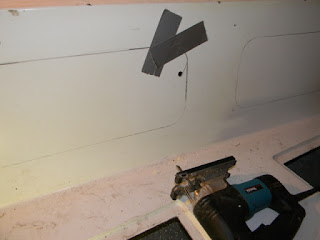 |
| The port side settee backrest shortly after the creation of the cutouts |
I used a jig of 3/8 inch plywood, which I had earlier created, to scribe the oval patterns for the cutouts in a consistent manner.
I considered using a Rotozip for this job, but decided it would not make a clean enough cut. The Rotozip is a tool primarily used for cutting dry wall, also known as sheet rock, in residential construction.
Instead, I used Bosch brand reverse cut blades, model T101BR in my Makita jig saw. I set the saw to its lowest speed, and I switched it from its oscillating cut mode to its straight up and down cut mode.
All three of these things, plus a slow pace produced a nice, clean cut with a minimal chipping of the fiberglass around the area of the cut.
At first, I used blue painter's tape along the line I had drawn. I thought this would also help reduce the chipping of the fiberglass. It proved unnecessary, so I did not tape any of the other parts of the ovals I had drawn.
Here is the port side as it appeared soon after I had completed the cuts.
Now I moved to the starboard side and did the same thing.
Notice how the work light is slipping down into a crack. Without the cord holding it in place, this light would have fallen down into the settee lockers under the seating area of the settee. I would need to do something to cover this crack on this side (and on the port side) if I ever wanted to stow anything in these newly available spaces.
The starboard side had more space behind the settee backrest than did the port side. This is because the starboard side settee is itself larger.
I used seven blades to make these four cutouts. Yes, that's right . . . seven blades.
This endss this posting on my creation of the cutouts for the backrests of the settees in Oystercatcher, my Ericson 25.



































No comments:
Post a Comment